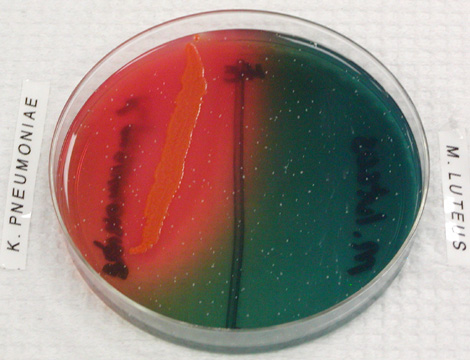Hektoen Enteric Agar
Hektoen Enteric Agar (HE) is a selective and differential medium designed to isolate and differentiate members of the species Salmonella and Shigella from other Enterobacteriaceae. Bile salts and the dyes bromthymol blue and acid fuchsin inihibit the growth of most Gram positive organisms. Lactose, sucrose, and salicin provide fermentable carbohydrates to encourage the growth and differentiation of enterics. Sodium thiosulfate provides a source of sulfur. Ferric ammonium citrate provides a source of iron to allow production of hydrogen sulfide from sodium thiosulfate, which provides a source of sulfur. Ferric ammonium citrate also allows the visualiztion of hydrogen sulfide production by reacting with hydrogen sulfide gas to form a black precipitate.
Enterics that ferment one or more of the carbohydrates will produce yellow to salmon-colored colonies. Non-fermenters will produce blue-green colonies. Organisms that reduce sulfur to hydrogen sulfide will produce black colonies or blue-green colonies with a black center.
 |
Klebsiella pneumoniae ferments lactose and produces salmon-colored growth. Micrococcus luteus does not grow. The white specks are crystals formed by a component of the media that precipitated out of solution when the plates were cooled. They look somewhat like a contaminant, but they do not interfere with the performance of the media. |
